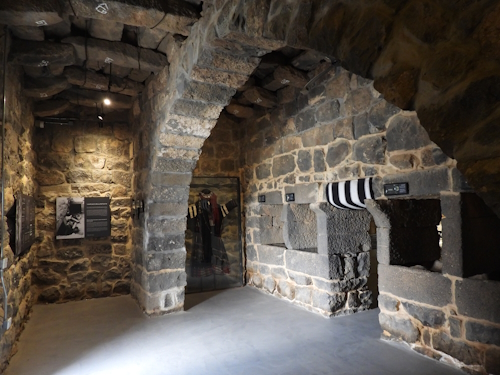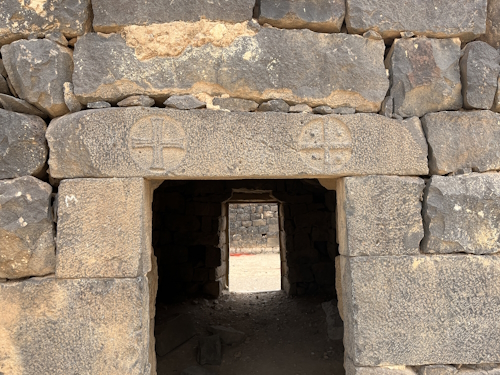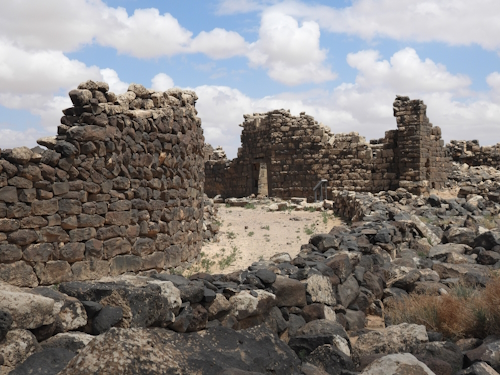Blog WHS Visits
WHS #958: Umm Al-Jimāl
One of the aspects that make Counting WHS more difficult than Counting Countries or Counting Regions is that the List is infinite and it will require you to backtrack to specific areas, whereas for the other lists, one visit suffices. Surely, many WH Travellers will need to retrace their steps for Umm Al-Jimal: only 28 of us made it to this recent WHS, while nearby Jerash has been seen by 121 and Quseir Amra by 174. On my 2012 Jordan trip, I covered those two as well and even Azrak Castle TWHS, but I did not make it to Umm Al-Jimal: it seemed too nondescript for a detour, as are Pella and Gadara, which also lie in the same region north of Amman.
Despite its relative obscurity, Umm Al-Jimāl has been praised as “an archaeologist’s dream”. It’s not hard to take pictures here that would make it look like a Roman-Byzantine site, and the even earlier Nabataeans passed here too, but 90% of the site consists of vernacular architecture based on locally available and finely cut basalt stones. The site museum glorifies the “indigenous people [probably Arab nomads who settled down].. who continued their traditions and were no puppets of the various rulers”; the OUV is also solely based on the rural lifestyle of these Hauranian people. At the time, around 500-800 AD, Umm Al-Jimāl was a prosperous town based on agriculture and serving the next major city of Bosra (nowadays 80km away by car since you have to find a border post into Syria, but as the crow flies or the camel walks it is only 25km).
The archaeological site still requires no entrance fee and can be entered both via the south (where a friendly tourist police station is) and the northwest (adjacent to the central street of the modern town). The south is the main entrance, and the first stop here is the small site museum. It occupies a restored house typical for the area, built with sturdy black basalt stones to withstand the heat and with the horse stables inside (photo 1). In the museum collection, the multilingual inscriptions stand out, such as the Dushara inscription on a cult stone with text in both Greek and Nabataean.
The site map displays a route along 33 monuments scattered around this vast site. The trails have no signage, so you just go out and explore, which is also one of the charms of the place. If you see an information panel, the associated building must have something of interest and you are free to walk in among the rubble. There were no other tourists present when I visited, I only saw some locals taking a shortcut through the area.
A major remain from the Ancient Roman era is the huge reservoir, which is filled with rainwater again since the successful restoration of a water channel in 2019. This is an example of how the local Hauranian people used the site: they made good use of what was left behind from the Roman and Byzantine periods and incorporated it into their town. It can also be seen in the enthusiastic use of spolia in the domestic buildings: many houses are decorated with Christian symbols taken from the churches.
The most intact area is the western part that adjoins the modern town. Streets with rows of houses are still present, many with characteristic exterior staircases. Here, you’ll also find some of the major buildings such as the West Church (with the arches almost complete), the Cathedral and the Praetorium (possibly a Roman governor’s residence). It ends up at the Barracks.
Getting there on public transport
The site is reachable by public transport from Amman, although it’s somewhat cumbersome. First, you have to make your way to the city of Mafraq. I had read online that it is served by buses from Amman’s main North Bus Terminal, but there they told me that there are no direct buses. Instead, I was sent to a roadside minibus stop towards to the town of Al-Zarka. At its terminal, I caught a large bus filled with university students going to Mafraq. At the bus terminal in Mafraq, I changed once again to a minibus to Umm Al-Jimal. They will drop you off in front of the site entrance (after doing a confusing loop through the modern town of the same name).
On the way back, I took the same minibus back to the Mafraq bus terminal and found a ‘white taxi’ (or servis: a shared taxi) directly to Amman. Bus rides cost between 0.5 and 1 JD, and the shared taxi was 2.5 JD per person. I had a print with me with the names of Mafraq, Umm Al-Jimal and Northern Busstation Amman written in Arabic – that was very helpful. Total travel time, including some waits, was over 2 hours on the way up and 1.5 hours coming back.
Els - 13 April 2025


